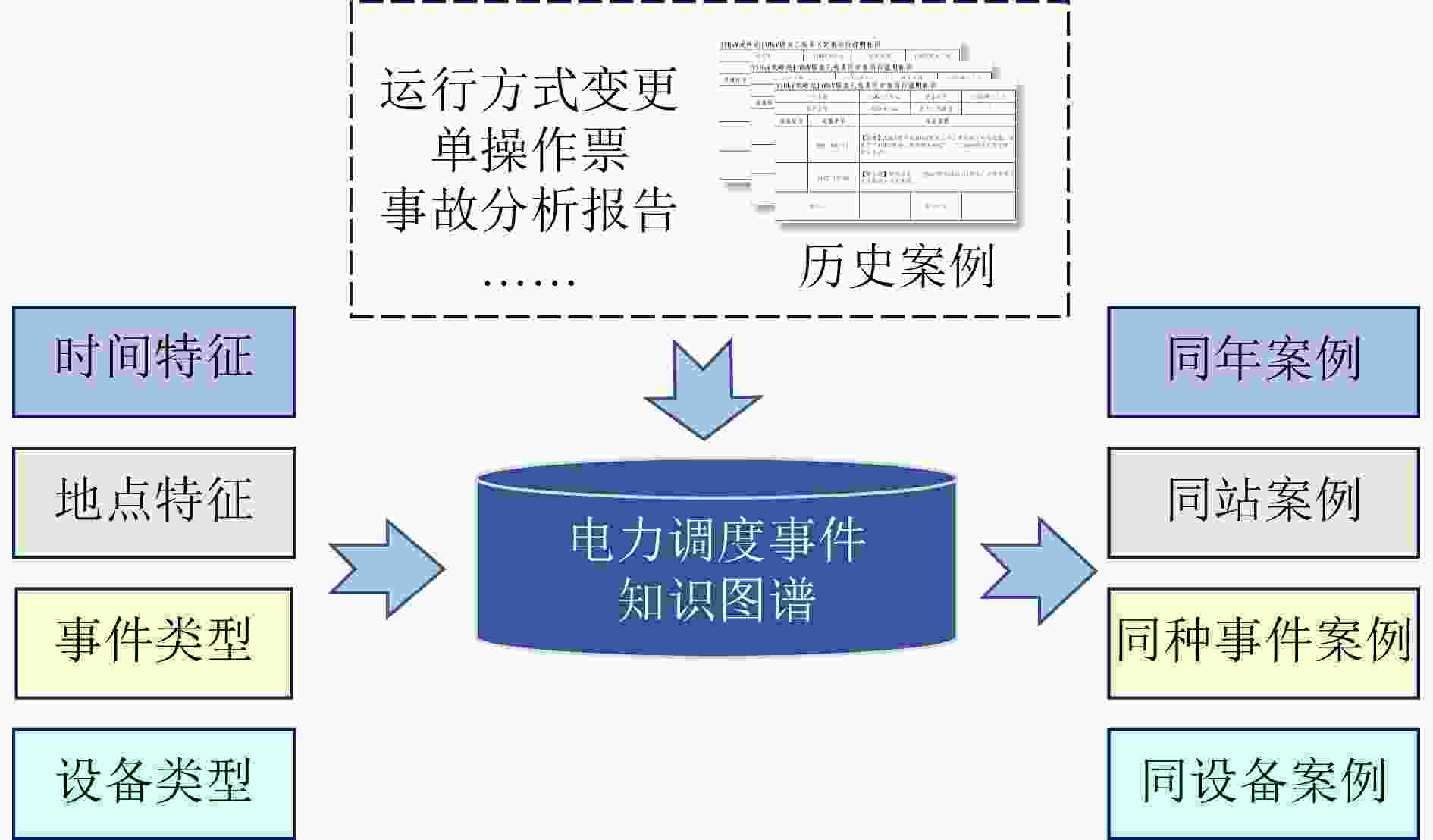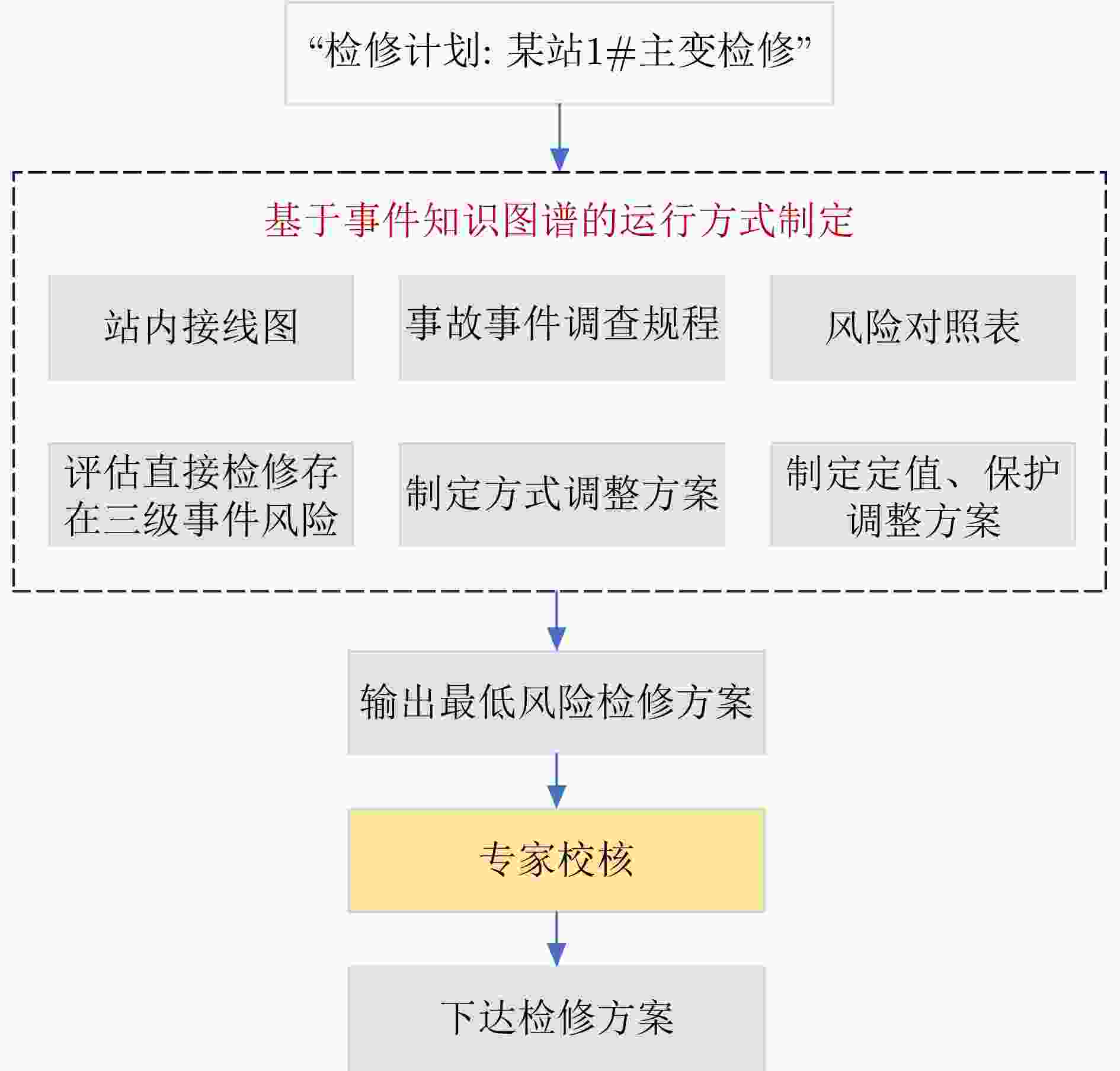A Review of Research Methods on Event Knowledge Graph for Power Dispatching
-
摘要: 事件知识图谱(EKG)是一种可学习事件演化规律的特殊知识图谱,具有推理、预测等功能。针对电力调度业务数据量大、模态多、交互耦合等特点,该文详述了面向电力调度的事件知识图谱的数据集构建、主流方法、技术架构、评价指标、适用场景等,重点分析各场景的可行性,并在应用流程、输入输出、技术架构等方面给出方案,最后对其在电力调度业务长期发展面临的难点和可能的研究方向进行了展望。该文研究为研究电力调度领域特点、事件知识图谱优势和两者结合提供了参考,并为事件知识图谱在电力调度领域中的应用方向提供了指导性思路。Abstract: Event Knowledge Graph (EKG) is a special knowledge graph that can learn the evolution laws of events, which has the functions of reasoning and prediction. In view of the characteristics of large amount of data, multiple modes and interactive coupling of power dispatching business, this paper describes in detail the dataset construction, mainstream methods, technical architecture, evaluation indexes, and applicable scenarios of the event knowledge graph for power dispatching, focuses on the feasibility of each scenario, and gives solutions in terms of application process, input and output, technical architecture, etc., and finally looks forward to the difficulties and possible research directions faced in the long-term development of power dispatching business. This paper provides a reference for the study of the characteristics of the field of power dispatching, the advantages of event knowledge graph and the combination of the two, and provides a guiding idea for the application direction of event knowledge graph in the field of power dispatching.
-
Key words:
- Event knowledge graph /
- Power dispatch /
- Event prediction /
- Big data
-
表 1 EKG中的典型事件关系类型
关系类型 关系概念 因果关系 A事件会导致B事件的发生 条件关系 条件结果关系,A事件会导致的结果 互斥关系 真假值逻辑,A事件发生时B事件不可能同时发生 顺承关系 先后发生逻辑,A事件发生后B事件发生 组成关系 事件之间整体与部分的关系 并发关系 事件的共生关系,A事件发生时B事件一定会发生 时序关系 时间顺序关系,A事件与B事件在时间轴上的关系 -
[1] 张智刚, 康重庆. 碳中和目标下构建新型电力系统的挑战与展望[J]. 中国电机工程学报, 2022, 42(8): 2806–2818. doi: 10.13334/j.0258-8013.pcsee.220467.ZHANG Zhigang and KANG Chongqing. Challenges and prospects for constructing the new-type power system towards a carbon neutrality future[J]. Proceedings of the CSEE, 2022, 42(8): 2806–2818. doi: 10.13334/j.0258-8013.pcsee.220467. [2] 张晓华, 刘道伟, 李柏青, 等. 智能全景系统概念及其在现代电网中的应用体系[J]. 中国电机工程学报, 2019, 39(10): 2885–2894. doi: 10.13334/j.0258-8013.pcsee.182003.ZHANG Xiaohua, LIU Daowei, LI Baiqing, et al. The concept of intelligent panoramic system and its application system in modern power grid[J]. Proceedings of the CSEE, 2019, 39(10): 2885–2894. doi: 10.13334/j.0258-8013.pcsee.182003. [3] 程凯强, 周照宇, 曹财云. 人工智能技术在电力调度自动化系统中的应用[J]. 集成电路应用, 2023, 40(4): 248–249. doi: 10.19339/j.issn.1674-2583.2023.04.113.CHENG Kaiqiang, ZHOU Zhaoyu, and CAO Caiyun. Application of artificial intelligence technology in power dispatching automation system[J]. Applications of IC, 2023, 40(4): 248–249. doi: 10.19339/j.issn.1674-2583.2023.04.113. [4] 吴旻哲, 张洁华. 电力调度自动化系统应用现状及发展趋势[J]. 产业创新研究, 2023(6): 21–23.WU Minzhe and ZHANG Jiehua. Current application status and development trends of power dispatch automation systems[J]. Industrial Innovation, 2023(6): 21–23. [5] 付饶, 袁丁, 刘琦, 等. 人工智能在电力调度自动化系统中的应用[J]. 集成电路应用, 2023, 40(2): 67–69. doi: 10.19339/j.issn.1674-2583.2023.02.024.FU Rao, YUAN Ding, LIU Qi, et al. Application of artificial intelligence in power dispatching automation system[J]. Applications of IC, 2023, 40(2): 67–69. doi: 10.19339/j.issn.1674-2583.2023.02.024. [6] XU Yi, OU Junjie, XU Hui, et al. Temporal knowledge graph reasoning with historical contrastive learning[C]. Proceedings of the Thirty-Seventh AAAI Conference on Artificial Intelligence, Washington, USA, 2023: 4765–4773. doi: 10.1609/aaai.v37i4.25601. [7] GUAN Saiping, CHENG Xueqi, BAI Long, et al. What is event knowledge graph: A survey[J]. IEEE Transactions on Knowledge and Data Engineering, 2023, 35(7): 7569–7589. doi: 10.1109/TKDE.2022.3180362. [8] 闪鑫, 陆晓, 翟明玉, 等. 人工智能应用于电网调控的关键技术分析[J]. 电力系统自动化, 2019, 43(1): 49–57. doi: 10.7500/AEPS20180629002.SHAN Xin, LU Xiao, ZHAI Mingyu, et al. Analysis of key technologies for artificial intelligence applied to power grid dispatch and control[J]. Automation of Electric Power Systems, 2019, 43(1): 49–57. doi: 10.7500/AEPS201806 29002. [9] 蒲天骄, 谈元鹏, 彭国政, 等. 电力领域知识图谱的构建与应用[J]. 电网技术, 2021, 45(6): 2080–2091. doi: 10.13335/j.1000-3673.pst.2020.2145.PU Tianjiao, TAN Yuanpeng, PENG Guozheng, et al. Construction and application of knowledge graph in the electric power field[J]. Power System Technology, 2021, 45(6): 2080–2091. doi: 10.13335/j.1000-3673.pst.2020.2145. [10] 乔骥, 王新迎, 闵睿, 等. 面向电网调度故障处理的知识图谱框架与关键技术初探[J]. 中国电机工程学报, 2020, 40(18): 5837–5848. doi: 10.13334/j.0258-8013.pcsee.200033.QIAO Ji, WANG Xinying, MIN Rui, et al. Framework and key technologies of knowledge graph based fault handling system in power Grid[J]. Proceedings of the CSEE, 2020, 40(18): 5837–5848. doi: 10.13334/j.0258-8013.pcsee.200033. [11] 周帆, 叶健辉, 肖林朋, 等. 基于知识图谱的电网模型本体智能问答系统研究[J]. 中国科技信息, 2019(16): 85–86. doi: 10.3969/j.issn.1001-8972.2019.16.033.ZHOU Fan, YE Jianhui, XIAO Linpeng, et al. Research on intelligent question answering system of power grid model ontology based on knowledge graph[J]. China Science and Technology Information, 2019(16): 85–86. doi: 10.3969/j.issn.1001-8972.2019.16.033. [12] 吴小刚, 许士锦, 陈兴望, 等. 基于知识图谱的电网智能调度辅助决策系统设计[J]. 信息技术, 2021(12): 60–65. doi: 10.13274/j.cnki.hdzj.2021.12.011.WU Xiaogang, XU Shijin, CHEN Xingwang, et al. Design of power grid intelligent dispatching assistant decision system based on knowledge graph[J]. Information Technology, 2021(12): 60–65. doi: 10.13274/j.cnki.hdzj.2021.12.011. [13] 刘广一, 王继业, 李洋, 等. “电网一张图”时空信息管理系统[J]. 电力信息与通信技术, 2020, 18(1): 7–17. doi: 10.16543/j.2095-641x.electric.power.ict.2020.01.00.LIU Guangyi, WANG Jiye, LI Yang, et al. "One Graph of Power Grid" spatio-temporal information management system[J]. Electric Power Information and Communication Technology, 2020, 18(1): 7–17. doi: 10.16543/j.2095-641x.electric.power.ict.2020.01.00. [14] 李文波, 贾嵘, 张怀春, 等. 基于配电网一张图的运营指挥系统研究[J]. 供用电, 2019, 36(11): 48–54. doi: 10.19421/j.cnki.1006-6357.2019.11.007.LI Wenbo, JIA Rong, ZHANG Huaichun, et al. Research on power equipment quality integrated management system based on graph database[J]. Distribution & Utilization, 2019, 36(11): 48–54. doi: 10.19421/j.cnki.1006-6357.2019.11.007. [15] 张虹, 景欣, 阮梦宇, 等. 基于知识图谱的交直流大电网断面越限处置策略快速生成方法[J]. 现代电力, 2021, 38(4): 455–464. doi: 10.19725/j.cnki.1007-2322.2020.0392.ZHANG Hong, JING Xin, RUAN Mengyu, et al. A method of fast eliminating transmission section overload based on knowledge graph in large-scale AC-DC power grids[J]. Modern Electric Power, 2021, 38(4): 455–464. doi: 10.19725/j.cnki.1007-2322.2020.0392. [16] 刘政昊, 曾曦, 张志剑. 面向应急管理的金融突发事件事理知识图谱构建与分析研究[J]. 信息资源管理学报, 2022, 12(3): 137–151. doi: 10.13365/j.jirm.2022.03.137.LIU Zhenghao, ZENG Xi, and ZHANG Zhijian. Research on construction and analysis of financial emergencies knowledge graph with event logical for emergency management[J]. Journal of Information Resources Management, 2022, 12(3): 137–151. doi: 10.13365/j.jirm.2022.03.137. [17] 曾子明, 李青青, 孙守强, 等. 面向突发公共卫生事件网络舆情的事理图谱构建及演化分析[J]. 情报理论与实践, 2023, 46(8): 147–155. doi: 10.16353/j.cnki.1000-7490.2023.08.018.ZENG Ziming, LI Qingqing, SUN Shouqiang, et al. Construction of the event evolution graph and analysis of evolutionary situation of network public opinion for public health emergencies[J]. Information Studies: Theory & Application, 2023, 46(8): 147–155. doi: 10.16353/j.cnki.1000-7490.2023.08.018. [18] 张海涛, 李佳玮, 刘伟利, 等. 重大突发事件事理图谱构建研究[J]. 图书情报工作, 2021, 65(18): 133–140. doi: 10.13266/j.issn.0252-3116.2021.18.014.ZHANG Haitao, LI Jiawei, LIU Weili, et al. Research on the construction of event knowledge graph of major emergencies[J]. Library and Information Service, 2021, 65(18): 133–140. doi: 10.13266/j.issn.0252-3116.2021.18.014. [19] GLAVAŠ G and ŠNAJDER J. Event graphs for information retrieval and multi-document summarization[J]. Expert Systems with Applications, 2014, 41(15): 6904–6916. doi: 10.1016/j.eswa.2014.04.004. [20] ROSPOCHER M, VAN ERP M, VOSSEN P, et al. Building event-centric knowledge graphs from news[J]. Journal of Web Semantics, 2016, 37/38: 132–151. doi: 10.1016/j.websem.2015.12.004. [21] GOTTSCHALK S and DEMIDOVA E. EventKG: A multilingual event-centric temporal knowledge graph[C]. 15th European Semantic Web Conference, Heraklion, Greece, 2018: 272–287. doi: 10.1007/978-3-319-93417-4_18. [22] LI Zhongyang, DING Xiao, and LIU Ting. Constructing narrative event evolutionary graph for script event prediction[C]. The 27th International Joint Conference on Artificial Intelligence, Stockholm, Sweden, 2018: 4201–4207. [23] DING Xiao, LI Zhongyang, LIU Ting, et al. ELG: An event logic graph[EB/OL]. https://arxiv.org/abs/1907.08015, 2019. [24] DENG Jinsheng, QIAO Fengcai, LI Hongying, et al. An overview of event extraction from twitter[C]. The 2015 International Conference on Cyber-Enabled Distributed Computing and Knowledge Discovery, Xi’an, China, 2015: 251–256. doi: 10.1109/CyberC.2015.24. [25] 肖乐, 岳思雯. 事件抽取技术综述及应用[J]. 软件导刊, 2023, 22(2): 218–224. doi: 10.11907/rjdk.221362.XIAO Le and YUE Siwen. Overview of event extraction technology and its application[J]. Software Guide, 2023, 22(2): 218–224. doi: 10.11907/rjdk.221362. [26] CHEN Yubo, XU Liheng, LIU Kang, et al. Event extraction via dynamic multi-pooling convolutional neural networks[C]. The 53rd Annual Meeting of the Association for Computational Linguistics and the 7th International Joint Conference on Natural Language Processing (Volume 1: Long Papers), Beijing, China, 2015: 167–176. doi: 10.3115/v1/P15-1017. [27] CHEN Yubo, LIU Shulin, ZHANG Xiang, et al. Automatically labeled data generation for large scale event extraction[C]. The 55th Annual Meeting of the Association for Computational Linguistics (Volume 1: Long Papers), Vancouver, Canada, 2017. 409–419. doi: 10.18653/v1/P17-1038. [28] SHA Lei, QIAN Feng, CHANG Baobao, et al. Jointly extracting event triggers and arguments by dependency-bridge RNN and tensor-based argument interaction[C]. The Thirty-Second AAAI Conference on Artificial Intelligence, New Orleans, USA, 2018. doi: 10.1609/aaai.v32i1.12034. [29] NGUYEN T M and NGUYEN T H. One for all: Neural joint modeling of entities and events[C]. The Thirty-Third AAAI Conference on Artificial Intelligence, Honolulu, USA, 2019: 6851–6858. doi: 10.1609/aaai.v33i01.33016851. [30] CHEN Yubo, LIU Shulin, HE Shizhu, et al. Event extraction via bidirectional long short-term memory tensor neural networks[C]. The 15th Chinese Computational Linguistics and Natural Language Processing Based on Naturally Annotated Big Data, Yantai, China, 2016: 190–203. doi: 10.1007/978-3-319-47674-2_17. [31] YANG Hang, CHEN Yubo, LIU Kang, et al. DCFEE: A document-level Chinese financial event extraction system based on automatically labeled training data[C]. ACL 2018, System Demonstrations, Melbourne, Australia, 2018: 50–55. doi: 10.18653/v1/P18-4009. [32] YANG Sen, FENG Dawei, QIAO Linbo, et al. Exploring pre-trained language models for event extraction and generation[C]. The 57th Annual Meeting of the Association for Computational Linguistics, Florence, Italy, 2019: 5284–5294. doi: 10.18653/v1/P19-1522. [33] DENG Shumin, ZHANG Ningyu, LI Luoqiu, et al. OntoED: Low-resource event detection with ontology embedding[C/OL]. The 59th Annual Meeting of the Association for Computational Linguistics and the 11th International Joint Conference on Natural Language Processing (Volume 1: Long Papers), 2021: 2828–2839. doi: 10.18653/v1/2021.acl-long.220. [34] DU Xinya and CARDIE C. Event extraction by answering (almost) natural questions[C/OL]. The 2020 Conference on Empirical Methods in Natural Language Processing (EMNLP), 2020: 671–683. doi: 10.18653/v1/2020.emnlp-main.49. [35] LIU Jian, CHEN Yubo, LIU Kang, et al. Event extraction as machine reading comprehension[C/OL]. The 2020 Conference on Empirical Methods in Natural Language Processing (EMNLP), 2020: 1641–1651. doi: 10.18653/v1/2020.emnlp-main.128. [36] NGUYEN T H, CHO K, and GRISHMAN R. Joint event extraction via recurrent neural networks[C]. The 2016 Conference of the North American Chapter of the Association for Computational Linguistics: Human Language Technologies, San Diego, USA, 2016: 300–309. doi: 10.18653/v1/N16-1034. [37] LIU Xiao, LUO Zhunchen, and HUANG Heyan. Jointly multiple events extraction via attention-based graph information aggregation[C]. The 2018 Conference on Empirical Methods in Natural Language Processing, Brussels, Belgium, 2018: 1247–1256. doi: 10.18653/v1/D18-1156. [38] ZHANG Richong, LI Junpeng, MEI Jiajie, et al. Scalable instance reconstruction in knowledge bases via relatedness affiliated embedding[C]. The 2018 World Wide Web Conference, Lyon, France, 2018: 1185–1194. doi: 10.1145/3178876.3186017. [39] GUAN Saiping, JIN Xiaolong, WANG Yuanzhuo, et al. Link prediction on N-ary relational data[C]. The World Wide Web Conference, San Francisco, USA, 2019: 583–593. doi: 10.1145/3308558.3313414. [40] GUAN Saiping, JIN Xiaolong, GUO Jiafeng, et al. NeuInfer: Knowledge inference on N-ary facts[C/OL]. The 58th Annual Meeting of the Association for Computational Linguistics, 2020: 6141–6151. doi: 10.18653/v1/2020.acl-main.546. [41] CHAMBERS N and JURAFSKY D. Unsupervised learning of narrative event chains[C]. ACL-08: HLT, Columbus, Ohio, 2008: 789–797. [42] GRANROTH-WILDING M and CLARK S. What happens next? Event prediction using a compositional neural network model[C]. The Thirtieth AAAI Conference on Artificial Intelligence, Phoenix, USA, 2016. 2727–2733. [43] HAN Zhen, WANG Yuyi, MA Yunpu, et al. The graph Hawkes network for reasoning on temporal knowledge graphs[EB/OL]. https://arxiv.org/abs/2003.13432v1, 2020. [44] HAWKES A G. Spectra of some self-exciting and mutually exciting point processes[J]. Biometrika, 1971, 58(1): 83–90. doi: 10.1093/biomet/58.1.83. [45] JIN W, QU Meng, JIN Xisen, et al. Recurrent event network: Autoregressive structure inferenceover temporal knowledge graphs[C/OL]. The 2020 Conference on Empirical Methods in Natural Language Processing, 2020: 6669–6683. doi: 10.18653/v1/2020.emnlp-main.541. -






 下载:
下载:









 下载:
下载:
